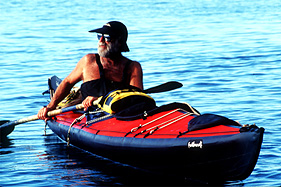
By Richard Roshon, Lecturer, Author, Kayak Entrepreneur Established 1975
Richard Roshon: A Sampling of Philosophies
March 2008,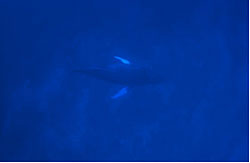 My guest, Ms. Kathy Ducommun from Wisconsin. It was Kathy’s second Kayak Experience with me in two years. And what an experience it was. My guest, Ms. Kathy Ducommun from Wisconsin. It was Kathy’s second Kayak Experience with me in two years. And what an experience it was. We depart from the shores of West Maui and hour before dawn. Beyond the reef all is silent except for the occasional breathing of North Pacific Humpback whales, which can be heard near and far. My guest becomes sensitive to silence for it brings peace within, as Kathy, sitting only a few feet from me in the forward cockpit whispers. 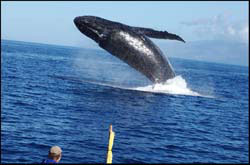 Engine noise, from boats leaving the harbor early in the morning are heard from miles away. Kathy’s first thought as to engine noise is to please go away. Ambient noise creates stress, heartbeat increases. For a female North Pacific Humpback whale noise could also decrease milk production. (Observing whales for more than 35 years from my ocean kayak I am convinced that nature is extremely sensitive, far beyond the our imagination.)  Keep in mind marine species are 20 times as sensitive to hearing as we ourselves. Living in the world’s largest echo chamber (the sea) sound travels 5 times further than in our atmosphere. Keep in mind marine species are 20 times as sensitive to hearing as we ourselves. Living in the world’s largest echo chamber (the sea) sound travels 5 times further than in our atmosphere. We are only a half-mile from the fringing reef when two North Pacific Humpback whales surface a mile away. A few deep breathes and they sound. For the next hour these two whales surface every 15 to 20 minutes, a few deep breathes and once again they sound around the same area. They are active and not much chance of having a closer look. From decades of observing North Pacific Humpback whales I believe this is a male trying to gain interest of the female. Keep in mind North Pacific Humpback whales make their annual migration to Hawaii to mate and give birth. So we sit patiently and observe the beautiful, majestic view of the West Maui Mountains. Observing whales breathing near and far, a green sea turtle su 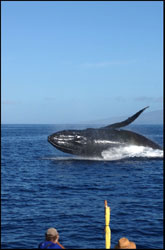 rfaces along side for a breath of air, and lies quietly on the surface, when suddenly the male and female surface only a few feet from the bow of the kayak, one breath, they sound and once again all is silent. rfaces along side for a breath of air, and lies quietly on the surface, when suddenly the male and female surface only a few feet from the bow of the kayak, one breath, they sound and once again all is silent.I didn't give much thought as to whether they would hang out since they were active and moving. But just then they both surface again close by. We have now drifted close to the outlining reef in about 80 feet of water. When a male tries to gain the interest of a female they usually move a lot covering a lot of area in a very short time, opposed to a female with a young calf, which may hang out in the same area for hours nursing and just resting. Another hour passes in which every 10 minutes the male surfaces and every 20 minutes the female will surface, close by and stays close to the kayak as if the kay 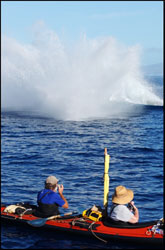 ak is giving protection from the male. The male is surely trying to gain the females interest as we watch him swim around the kayak. ak is giving protection from the male. The male is surely trying to gain the females interest as we watch him swim around the kayak.At the same time Mark Ferrari, founder of “Center for Whale Studies” has been watching from his research boat, and slowly approaches. Mark slowly and quietly gets in the water, and photographs the marking on the female, which is now lying on the bottom. What is unusual is that this female has white pigment markings on, the dorsal or topside of her pectoral fins. With Mark back on board his research boat, the male circles, and then begins to breach. Mark took some great photographs of the male breaching alongside our kayak. One of the many natural wonders of the world. Time passes by, when eventually these two whales make there way north. I paddle Kathy back to shore knowing that this experience was one she will never forget. January, 2003 Under a
tropical starlit sky I paddled Professor Richard Brooks beyond the reef,
and into the world of whales. Phosphorous glitters as the kayak glides
over a pristine sea.
With the approach of dawn, silence is broken by the long drawn out breathing of North Pacific Humpback Whales. As the sun rises over the 10,000 foot summit of Haleakala Crater, a malia (light) breeze approaches from the north, drawing our attention to the powerful breathing from numerous Humpback whales in the distance. From another direction a pod of fast moving whales moves into the same area. Both groups merge and begin what I call a competitive heat run between males. I am able to distinguish a dozen whales, now heading in our direction. I continue to paddle slowly out to sea, hoping to arrive at their parallel before they pass. Minutes later they surface, one blow after another exchanging huge amounts of air. They sound, and once more all is quiet. Having changed their course to the open ocean we sit in awe as they pass several hundred yards ahead. It's quite amazing to hear a dozen full grown whales exchanging what is estimated to be about 2500 gallons of air in less that two seconds. The last of a dozen whales sound, and once again all is silent. A few minutes later they surface and are now heading directly towards us, creating their own wave by their powerful forward movement. Then it happens; Twenty yards off our starboard side I spot a Humpback whale about to surface. He rises, arching his hump to such a degree; it looks as though his head could touch his flukes. He sounds directly under the kayak. We scan the surface and the abyss below. It is truly a scene from Moby Dick. A few seabirds circle, as endless moments turn into endless minutes. Somewhere below a dozen whales weighing 40 tons each are swimming freely in their weightless environment. "They Rise" Cries, Captain Ahab. The silence is broken by the release of huge amounts of air. One Blow, then another, filling the atmosphere with a misty haze.
Several whales swim under the kayak. With pectoral fins extended like the wings of an eagle they glide in silence. I hold my trusty old waterproof Nikonos II camera along side the kayak and snap off a few underwater pictures - hoping that something will turn out. For the next half hour they swim under and around us. Since 1975 I have spent my life with whales from and ocean kayak. I distinguish one whale from the other by scares, shapes of the dorsal fin, and pigment markings on the under side of their flukes. I notice that even though the two pods are swimming together, they tend to stay in their own group. They don't intermingle, and use the kayak as a boundary. One group on one side, the other group on the other. Something to think about? Why would they suddenly change their direction toward us? Did they detect an object in the water? Curiosity? A habit of all species. Why did they congregate around the kayak? For whatever reason, being in the presence of the 5th largest species of the cetacean society, with all their power and beauty, was truly an awe-inspiring experience. For we truly had front row seats.
My guest was Mrs. Lenore Finny, a beautiful lady in her 60's, full of energy, and so excited to enter the world of whales that she couldn't sleep the previous evening. I paddle Lenore beyond the reef and the sound made by breaking waves. By the light of the full moon, we soon become as fragile as our surrounding natural environment. Silence is broken by the long drawn out breathing of North Pacific Humpback whales, as they lie quietly, resting on the surface.
The Auau channel flows between the islands of Maui, Kahoolawe, Lanai, and Molokai. It once contained the largest number of Humpback whale sightings during their winter migration to the Hawaiian Archipelago. Protected from open ocean ground swells, the average depth is only 300 feet. This area creates the only protected body of water in the North Pacific Ocean. An ideal environment for North Pacific Humpback whales to mate and give birth. In the early morning light, two whales surface directly ahead, slowly exhaling large amounts of air. With the coming of dawn, the slapping of peck fins, and flukes echo across the surface of the sea. The Valleys of the West Maui Mountains begin to show their majestic outlines, as shadows give way to the light of the early morning sun. Mothers
with their newborn calves have been swimming in the shallows just beyond
the reefs of Lahaina town throughout the night. With the departure of
numerous engine-powered whale-watching boats our whale sightings disappear.
The noise is disturbing not only to whales but for Lenore and myself,
who for the past 3 hours have been sitting in complete silence in the
presence of whales. We are mesmerized, and have become just as fragile
to unnatural disturbances as nature itself. By 10 AM, due to the hot Lahaina sun reflecting from the surface of the sea, aided by the slow movement of the kayak, I decide to lie back for a short nap. Lenore sits patiently in the front cockpit keeping a vigil eye out for sightings. Just as I am about to doze off, Lenore spots a mother and calf 2 miles in the distance, just outside the reefs of Lahaina. Putting my nap on hold, I get things back together and slowly begin paddling towards the shoreline. Watching for the young calf to surface will indicate what direction they are moving, for the mother is always close by. (A newborn calf, from the day it is born will eventually develop the ability to hold its breath for longer intervals. But it takes time. The young calf will surface an average of every 3-5 minutes, take in a few deep breathes and sound. After 3-4 breathing sequences the mother will then rise for her all-important breath of air. From the eyes of a kayak, the difference of breathing between mother and calf are distinguished. What I try to do is position myself far ahead of whales, hoping they will stay on the same course. Time and patience are requirements in observing nature with respect. A KAYAK CAN BE A DISTURBANCE - I DO NOT PADDLE TOWARDS WHALES.
Suddenly 30 feet in front of our bow a calf surfaces. However this is not the same mother and calf pair that Lenore spotted. The calf surfaces only once with no sign of the mother. We sat for a few moments, when 200 yards away the mother rises expelling large amounts of air. She lies quietly on the surface, as we sit and observe her next move. A few deep breaths and she slowly sounds. We continue to wait, scanning the waters for their presence. Then, 20 feet off our port beam the calf surfaces swimming upside down and showing off it's side pectoral fins. The mother then rises directly in front and partially under the bow of the kayak, allowing the kayak to roll ever so slowly from her back. With the kayak facing into the on-coming current, the mother's body is forced against the bow of the kayak. She lies directly in front of the kayak and naps, raising her blowhole above the surface every 10 minutes or so for a breath of air. Her calf swims leisurely by her side.
An hour
passes by, and we wonder how long this wonderful experience will last.
I don't want to back away from the mother, as I'm afraid that she will
be disturbed. One of the most important senses of this species is the sense of touch. Touching creates a bonding and security. From mothers to fathers, to sisters and brothers. From friends to friends, and one nationality to another - touching is so important as we become a global community. After an hour or so, our experience comes to an end. There were no boats within 5 miles. However about 200 yards away I hear the voices from crew members of several outrigger canoe clubs as they yell out their paddle changes. With these changes, paddles occasionally hit the side of the canoes. (That sound does echo across and into the ocean) I can only surmise that this noise lead to the exchange of large amounts of air by the female Humpback. The mother and calf then sound, and are seen no-more. Over the past 25 years, frequent encounters of females lying directly under my kayak, leads me to believe that the kayak is used as a safe haven. Anything that floats on the surface of the sea creates a harbor of refuge. Small reef fish, sea spiders, & crabs may use flotsam as protection from the sun, as well as safety from predators by hiding in its shadows. My kayak is used in the same way. Dozens of small fish an inch long will lie in the shadows of the kayak miles from shore, protecting them from the sun and predators. The whale is no different. From large to small we all look for protection or security in one way or the other. The kayak I use for my Private Kayak ventures is the Feathercraft skin kayak. Since 1975 I have been kayaking a custom fiberglass kayak. I have had many encounters with whales lying under or alongside. However in the few years that I have been paddling the Feathercraft skin kayak, frequent encounters of whales lying by the side or under is unbelievable. I really believe that the skin of this kayak, which is made of "Hypalon - a neoprene synthetic rubber, creates a very friendly reading from whales. More so than my hard shell kayak.
My guest Mr. William Keown from Minnesota, an avid wildlife photographer. William, brought along some very impressive camera lens, with a very fast motor drive. With the
break of dawn we saw lots of whale action several miles into the channel.
Much to far to paddle, knowing that whales will certainly not be there
when we arrive. One hour goes by and no sign. I placed my paddle in my holders - pulled back my spray skirt to grab a sandwich when suddenly mother, calf and escort surface alongside. For the next three hours we sat in awe, drifting with the current while the mother, calf and escort seemed to be very occupied with our presence. The mother
and calf were always together, and would rise frequently. The escort
would show his presence by surfacing directly in front of the kayak
or as if to be the starship Enterprise - drift quietly under the kayak. 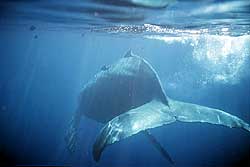 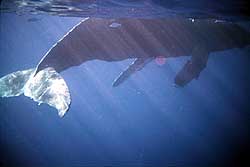
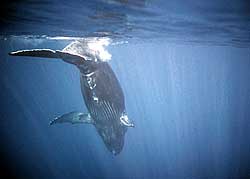
|
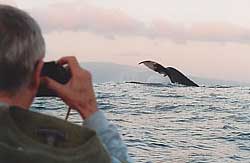
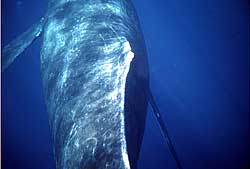


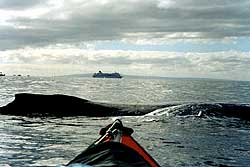
 This Site hosted by
This Site hosted by